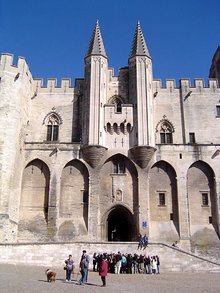Palais des Papes
|
|
The Palais des Papes in Avignon, France is one of the largest and most important medieval Gothic buildings in Europe. It is one of many places called the Palace of the Popes.
Avignon became the residence of the Popes in 1309, fleeing the violent chaos of Rome. The Palais was built between 1335 and 1364 on a natural rocky outcrop at the northern edge of Avignon, overlooking the river Rhône. The site was formerly occupied by the old episcopal palace of the bishops of Avignon. The Palais was built in two principal phases with two distinct segments, known as the Palais Vieux (Old Palace) and Palais Neuf (New Palace). By the time of its completion, it occupied an area of 2.6 acres (11,000 m²). The building was enormously expensive, consuming much of the papacy's income during its construction.
The Palais Vieux was constructed by the architect Pierre Poisson of Mirepoix at the instruction of Pope Benedict XII. The austere Benedict had the old episcopal palace razed and replaced with a much larger building centred on a cloister, heavily fortified against attackers. Its four wings are flanked with high towers.
Palais_des_papes_grand_chapel.jpg
Under Popes Clement VI, Innocent VI and Urban V, the building was expanded to form what is now known as the Palais Neuf. Jean de Louvres was commissioned by Clement VI to build a new tower and adjoining buildings, including a 52 m long Grand Chapel to serve as the location for papal acts of worship. Two more towers were built under Innocent VI, and Urban V completed the main courtyard (known as the Court d'Honneur) with further buildings enclosing it. The interior of the building was sumptuously decorated with frescos, tapestries, paintings, sculptures and wooden ceilings.
The popes departed Avignon in 1377, returning to Rome, but this prompted the Papal Schism during which time the antipopes Clement VII and Benedict XIII made Avignon their home until 1408. The latter was imprisoned in the Palais for ten years after being besieged within in 1398. The building remained in the hands of antipapal forces for some years – it was besieged from 1410 to 1411 – but was returned to the authority of papal legates in 1433.
Although the Palais remained under papal control (along with the surrounding city and Comtat Venaissin) for over 350 years afterwards, it gradually deteriorated despite a restoration in 1516. When the French Revolution broke out in 1789 it was already in a bad state when it was seized and sacked by revolutionary forces. In 1791 it became the scene of a massacre of counter-revolutionaries, whose bodies were thrown into the Tour des Latrines in the Palais Vieux.
The Palais was subsequently taken over by the Napoleonic French state for use as a military barracks and prison. Although it was further damaged by the military occupation – the frescos were covered over and largely destroyed – ironically this ensured the building's physical survival. It was only vacated in 1906, when it became a national museum. It has been under virtually constant restoration ever since.
The majority of the Palais is now open to the public; it also houses a large convention centre and the archives of the départment of Vaucluse.

